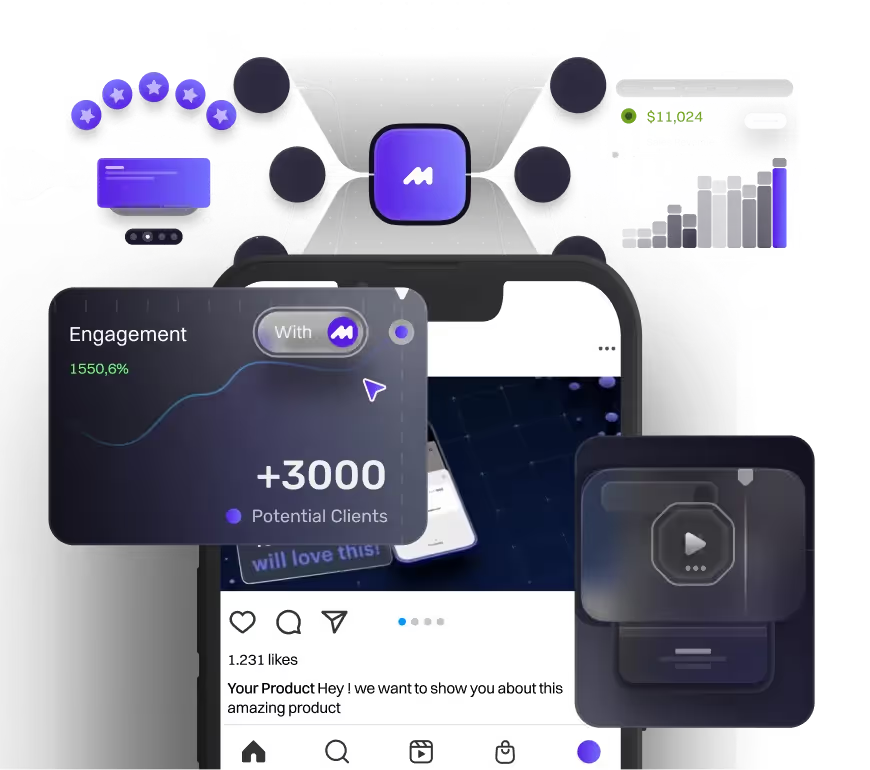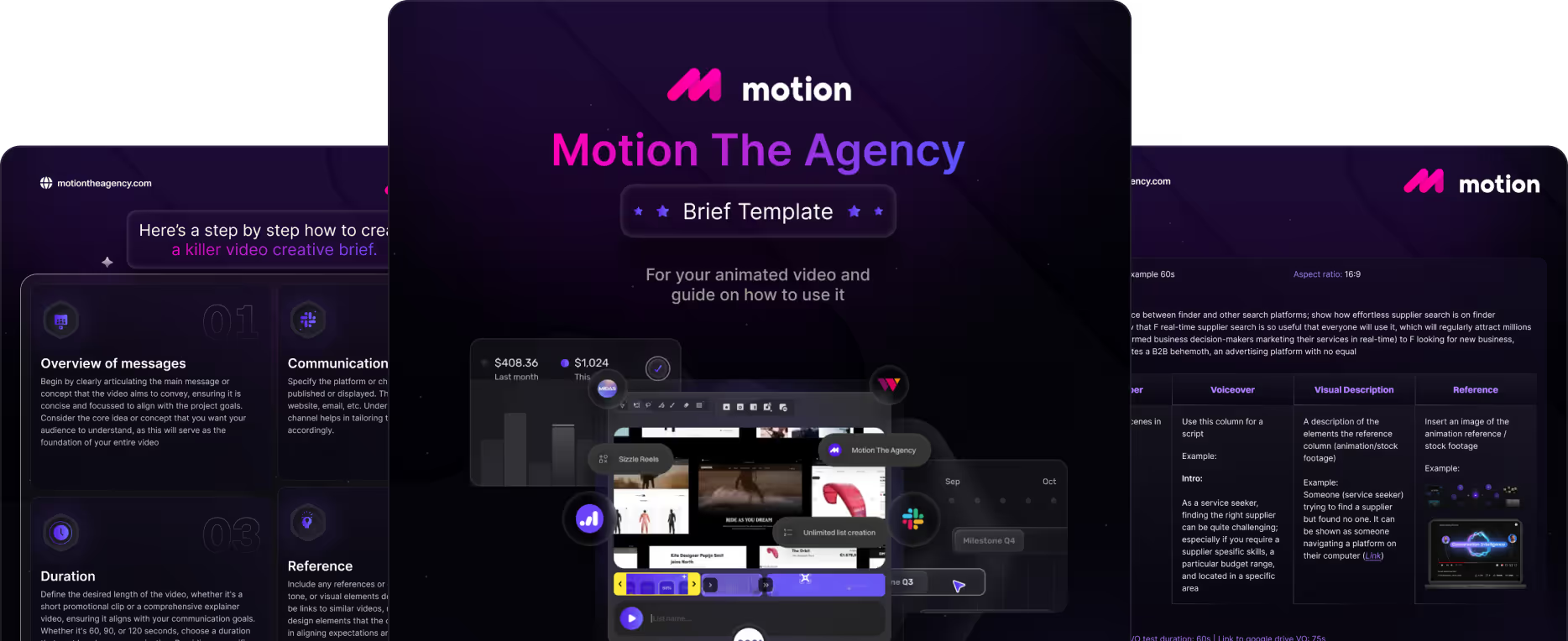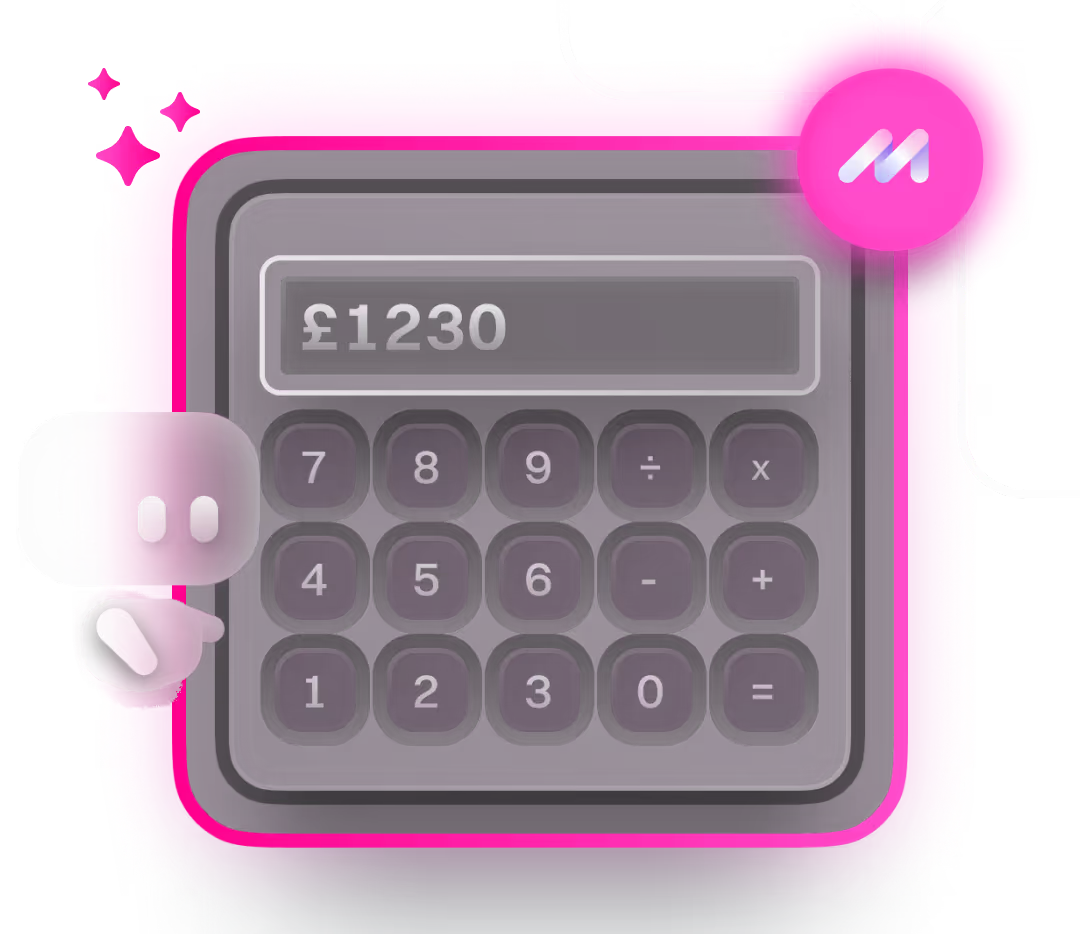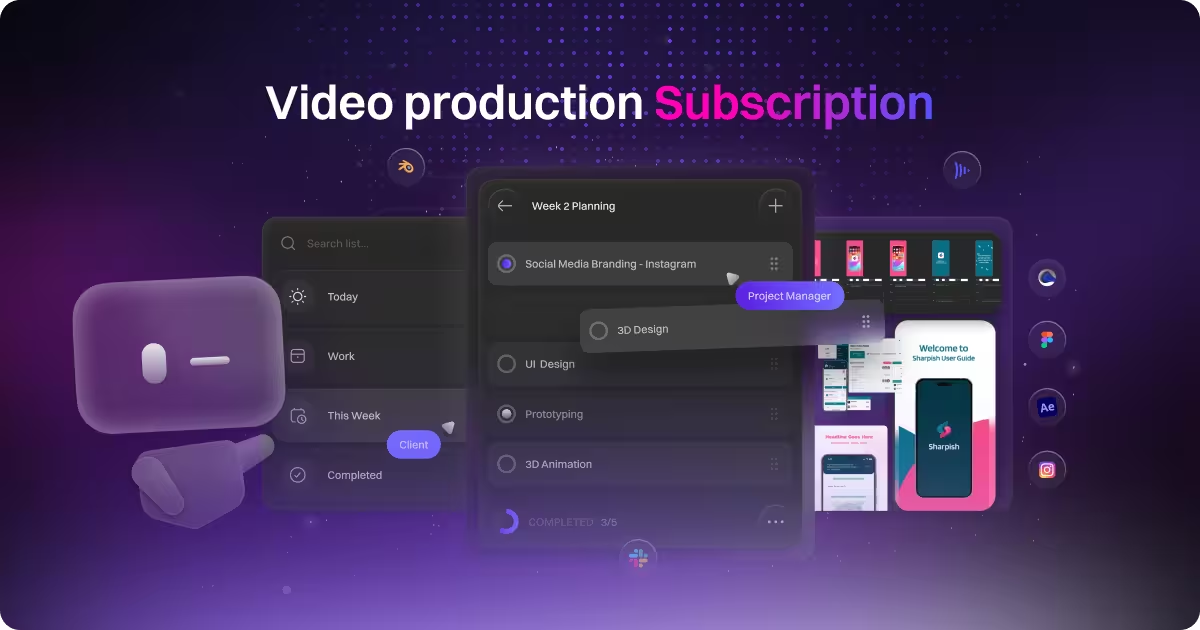2D vs 3D Animation Videos: Which Animation Style Fits Your Brand Best?
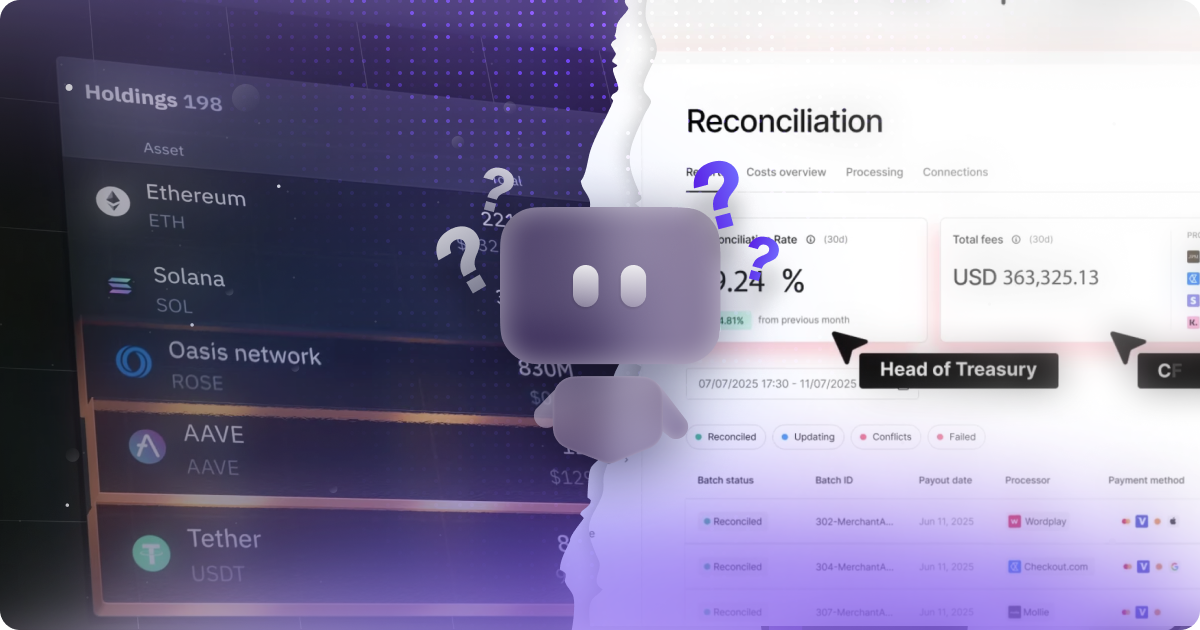

table of content
If you’ve found this blog while thinking about creating a product or promotional video for your company but aren’t sure which format to choose, you’re in the right place. We’re Motion The Agency, a motion design studio that lives and breathes animated videos. Whether you’re after a product video, an explainer, or a branded commercial, animation is a powerful way to convey your message. From 2D to 3D or something in between, we specialize in creating animations that help brands connect and convert, no matter the format.
The main difference between 2D and 3D animation is how things move and feel. 2D is flat, with characters and objects moving side to side or up and down. 3D adds depth, so things feel more real and pop out at you. A simple way to tell: if everything blends into the background, it’s probably 2D. But if objects feel like they’re standing out or floating in space, that’s 3D.
Both styles work really well for product videos or any kind of promo. With animation, you can easily show off features that might be hard to capture in real life. It helps explain complex ideas and how your product actually works in a way that’s clear and engaging. So the real question is, which one is better: 2D or 3D animation?
Let’s talk about it!
2D vs 3D Design and Animation
Before we dive into the difference between 2D and 3D animation, it's worth mentioning that these terms also apply to design. Since this article mainly focuses on animation, we'll briefly touch on the design side.

2D design is flat. It only uses height and width, and you’ll typically see it in UI layouts, app screens, and infographics, where depth is suggested through layering or shadows.
3D design adds depth, volume, and realism. You can rotate objects, play with lighting, and position them in lifelike environments. It's perfect for mockups or isometric visuals.
Even though 2D and 3D animation are pretty different and used in different ways, when we’re talking about 3D design, the process often overlaps with animation. It usually starts with building or modeling objects in tools like Blender or Cinema 4D, whether you’re making a still image or a full-on animation.
In real-life design, 2D and 3D tend to be used differently:
Use 2D Design when:
- You need something clean, flat, and fast to produce
- You're working on interfaces like app screens, dashboards, or icons
- Your goal is clarity and minimalism
- You want a lightweight visual style that’s easy to adapt and scale
Use 3D Design when:
- You want to showcase a product realistically (mockups, packaging, etc.)
- You need depth, dimension, and dynamic angles
- You're aiming for a more polished, premium, or modern look
- You want to stand out in ads, hero visuals, or high-impact brand content
2D vs 3D Animation: Whats the Differences
Now that we’ve broken down 2D and 3D design, let’s talk about how they move in animation. The easiest way to tell the difference is this: 2D animation feels flat, like everything’s moving on a surface. 3D animation has depth, so objects can rotate, tilt, and be seen from different angles.
.png)
That’s because 2D animation is limited to the XY axis, meaning movement happens across length and width only. In contrast, 3D animation exists on the XYZ axis, so you get length, width, and depth. That extra dimension means the object can move in space and be seen from any angle.
Now, let’s dive deeper.
Let’s Start With, What is 2D Animation?
2D animation is flat. Everything moves on a surface, side to side, up and down, but there's no depth. If it looks like it could be drawn on a piece of paper, it’s probably 2D.
You’ve seen it everywhere: cartoons, explainer videos, UI demos. It started as hand-drawn frame-by-frame work, but now it’s mostly digital using tools like Adobe After Effects, Toon Boom, or Animaker.
Why people choose 2D:
- Clean, stylized visuals that get the point across
- Fast to produce and easy on the budget
- Perfect for UI, tutorials, or brand stories that need to move quickly
What About 3D Animation?
3D animation adds depth. Objects move in every direction, and you can see them from all angles, just like in real life.
It’s the kind of animation you’ll see in product demos, video games, or 3D ads. With tools like Blender, Cinema 4D, and Maya, you can rotate, zoom, light, and texture every part of a scene to make it feel real.
Why 3D stands out:
- More dynamic movement and camera control
- Realistic lighting, shading, and textures
- Great for showing off products or creating immersive visuals
Want to go deeper? Check out our blog: What is 3D Animation
So, What are the General Differences?
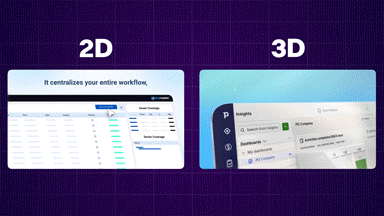
Okay, take the GIF above for example. Both show a stylized animated UI, but one clearly uses depth in the movement. You can see objects rotating, the camera shifting angles, and it all feels like something that could happen in the real world. That’s 3D.
The 2D example, on the other hand, is more limited in movement. The movement stays flat, only along the X and Y axis. There’s no real sense of depth, and you don’t see shadows or angles that suggest space.
Real-Life Examples of 2D and 3D Animation from Our Projects
2D Animation Example Project
On the other hand, we also get a lot of projects that choose 2D animation. As we mentioned earlier, every company has different needs for their product or marketing video, and 2D animation might be a better fit for some. Companies that choose 2D usually do so because of their branding, or because they’re working with a tight schedule or budget. But that doesn’t mean one is better than the other. Now, let’s take a look at our recent 2D animated video project with Primer:
Workflow: Concepting - Storyboard - Animation - Sound design and Other finishing touch - Final render
Timeline: around 6-12 days of work depending on the length of the project video
Technique:
- Stroke lines
- We designed custom strokes using masking and effects to create smooth, flowing outlines.
- Parallax animation
- We layered elements to move at different speeds, creating a sense of depth and movement.
3D Animation Example Project
Okay, we’ve mentioned briefly in the table above that 3D animation is often used when people need a more realistic and modern feel to their videos, especially when showcasing products or environments. Now, let’s take a deeper dive into how we as an agency handle 3D animated projects. Using our latest 3D sample for Pipedrive as an example, we’ll walk you through the workflow, timeline, and costs involved.
Workflow: Concepting - Storyboard - Previsualization - Modeling - Texturing - Rigging - Blocking - Animation - Lighting - Test render - Compositing - Editing and sound design - Final render
Timeline: around 10-24 days of work from start to finish, for 60-90 seconds video, could be less depending on the video direction, we actually did a deep dive on our 3D animation precess in our blog “3D Animation, VFX, and Motion Design: What Sets Them Apart?”
Technique:
- Exploded view
- Breaks the product into layered parts to show how everything fits together, like a behind-the-scenes build.
- Cutaway render
- Slices the product open to reveal what’s inside — a clean, stylized way to show internal components.
Why Animation Works for Companies
Animation is seriously one of the best ways to break down complex ideas and bring them to life. It lets you show things that live action simply can’t. Like, ever tried filming the inside of a car engine while it’s running? Yeah, not happening. But with animation, you can show every moving part without lifting a wrench.
It’s also usually way more affordable than shooting live. No need to book locations, hire actors, or rent a bunch of gear. You just focus on the visuals and the message. And when you’re working on a tight timeline, animation’s faster to turn around too.
Now, when it comes to 2D and 3D, they each have their own strengths. They’re built for different types of stories, so depending on your goals, one format might make more sense than the other.
Lets’s dive in:
Why 2D Animation Works
Best for: Startups, SaaS platforms, educational content, quick explainers
If you’re looking for something that’s fast, affordable, and easy to roll out, 2D animation is your go-to. It’s super efficient to produce, which means less back-and-forth and more speed to launch. Perfect when you’ve got tight deadlines or need content that’s always moving.
But it's not just about being budget-friendly. 2D is great at breaking down complex ideas in a fun, simple way. It’s clean, easy to follow, and feels personal. That’s why it works so well for explainers, social clips, and anything concept-driven.
Why 3D Animation Works
Best for: Tech, architecture, product walkthroughs, high-end brands
When you really want to impress, 3D is where it’s at. It’s sleek, detailed, and gives you full control over lighting, movement, and depth. You can zoom into the tiniest part of a design or build out entire worlds from scratch.
It’s also super useful when you're showing off physical spaces, complex systems, or anything that needs a bit more realism. It just feels more polished and premium, which makes it a great fit for brands that want to stand out.
We covered on the specific of industries that need 3D animation in our blog “Who Needs (and Doesn’t Need) 3D Animation?”
Can We Combine Them?
Well, yes. There is a style called hybrid animation that combines both 2D and 3D to create a more dynamic and flexible format. This approach is often used by brands that want to showcase their product in a polished 3D style but still keep the simplicity and cost-effectiveness of 2D animation.
In hybrid animation, designers might use 3D models to highlight the product itself, giving it realistic lighting, movement, and depth, while supporting elements like text, icons, or storytelling scenes are handled in 2D. This not only keeps the visuals engaging, but also helps control production time and budget. It’s a great way to get the best of both worlds without fully committing to the complexity of a full 3D pipeline.
So, Which Type of 3D or 2D Animation You Should Choose?
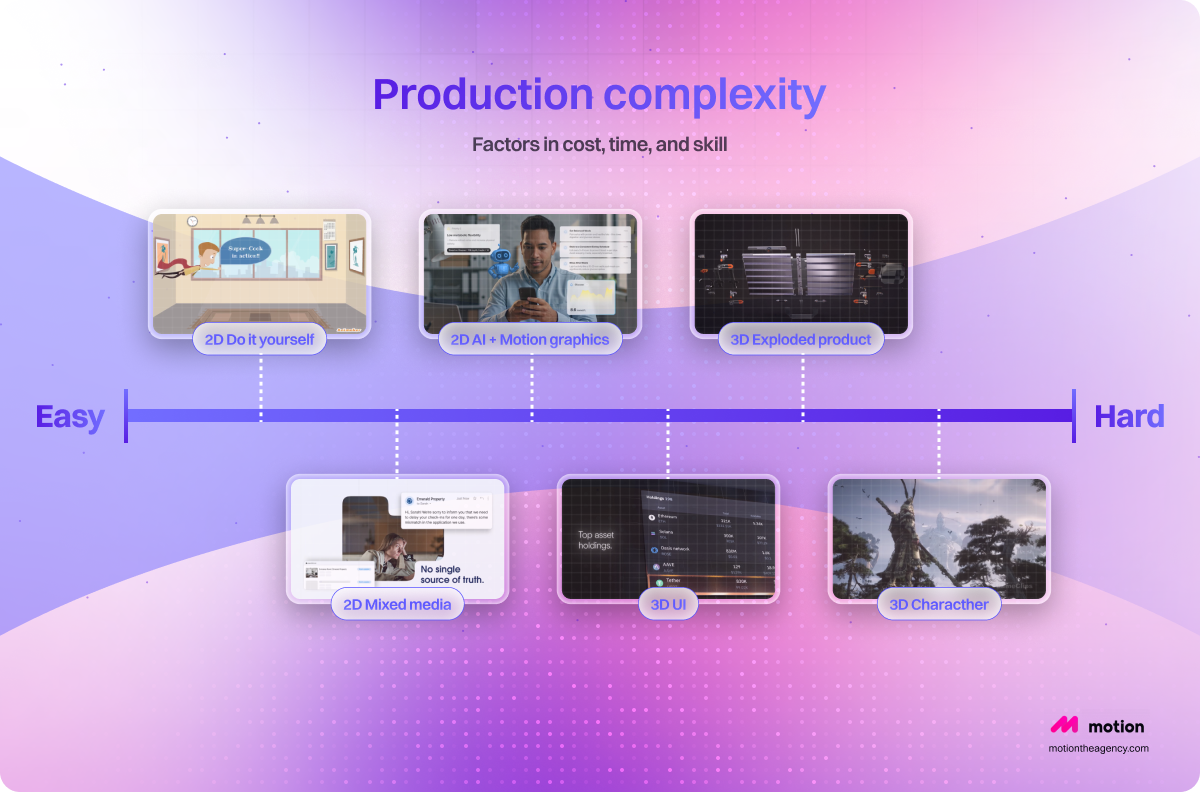
Not all animation is created equal. Even with 2D, there’s a big difference between using a quick template on something like Animaker and building out a custom animation with detailed UI elements and motion graphics. Both are 2D, but one takes way more time, skill, and effort to get right.
Same with 3D. A simple 3D interface animation is pretty straightforward. But creating a full character animation like you’d see in a movie? That’s a whole different level.
So how do you know what to go with? It really comes down to what you're trying to say and the resources you have. Every brand is different. Every project has its own goals, message, and style. What works for one might not work for another.
Before you dive in, think about what you're actually aiming for. Do you want to build trust, explain something complex, or just create something that looks bold and impressive? Once that’s clear, picking the right style becomes a lot easier, and you’ll get more value out of whatever you create.
So, we actually have tool that might help you understanding your company needs and how to budget around it better! feel free to try our cost calculator for free, to get the estimation of the cost of your next video project.
The Main Differences Between 2D and 3D Animation Outsourcing
If we are comparing 2D and 3D animation, we also need to look at how the outsourcing process works for each. Before we get into the differences, it helps to clarify what outsourcing actually means. In the simplest definition, outsourcing is when a company hires an external team or specialist to handle a task, service, or project instead of doing it internally.
For animation, this means brands bring in outside experts to produce content faster, at a higher quality, or with skills they do not have in-house. Many companies rely on outsourcing for campaigns, product explainers, and ongoing content because building a full internal animation team is expensive and slow.
In this section we will break down the differences between outsourcing 2D animation and outsourcing 3D animation, and what each process involves so you know exactly what to expect.
Portfolio & style match
2D and 3D animation are completely different styles, and even within each category there are multiple sub-styles that look and feel very different from one another. You might want a clean, vector-based motion design video, but a studio that specializes in 3D character animation will not have the skills or tools to create that style. The same applies the other way around.
This is why checking a studio’s portfolio is one of the most important steps when outsourcing animation. You need to see if their past work matches the exact look, feel, and structure you want for your project. A studio can be great, but still be the wrong fit for your style.
Always remember this simple rule: style mismatch equals endless revisions and wasted cost.
Turnaround time
Another thing thatyou need to pay attention to is the turnaround time. we know that every project has their own timeline and what they considered importnat, ifyour project need time and efficiency mor than anything, maybe chosing a less time consuming project the better, but if not vice versa
But, Why Do Companies Choose Animation Over Live-Action Video?
Simple. They work, and they work across the board.
First off, they boost engagement big time. People remember visuals way better than plain text. In fact, viewers retain around 95% of a message when it’s delivered through video, compared to only 10% when reading. That’s a huge win if you're trying to simplify something complex or make your message stick.
They also build trust and brand recall. When your video nails your visual identity and tells a story that connects, people remember it. Animation makes your brand feel more polished, more consistent, and way more memorable.
And the best part? You can use the same video across your entire funnel. From product pages to email flows, social ads, or even in-app walkthroughs, one solid piece of content can scale across every platform and still hit hard.
Conclusion
Whether you go with 2D, 3D, or something in between, animation is one of the most effective ways to bring your product or services to life. It helps simplify complex ideas, grabs attention fast, and gives your brand a visual edge that sticks. More than just making things look good, a well-executed product video can boost engagement, clarify your message, and drive real business results.
At the end of the day, the right style comes down to your specific goals, your timeline, and what your audience actually responds to. There’s no single right answer, but there is a smart choice for your brand. If you're clear on the story you want to tell and the experience you want to create, animation gives you the tools to make it happen.
If you’re exploring ideas for your next product video, feel free to check out our animated product video services or book a quick call, happy to chat through what might work best for your brand.

Contact Us
Ready to elevate your brand? Contact us for your
Free Custom Video Sample
